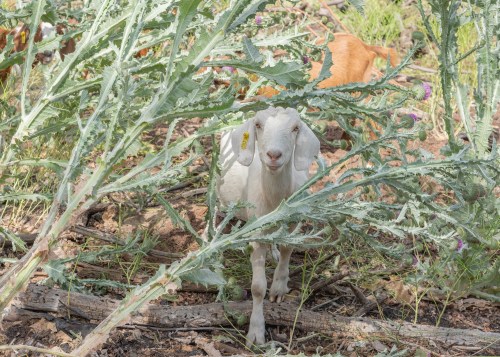Hooves on the ground: Goats join Pendleton wildfire prevention effort this dry season – East Oregonian

Report on Pendleton’s Wildfire Prevention Initiative Utilizing Goats
Introduction
In response to the increasing wildfire risk during the dry season in Eastern Oregon, the Pendleton Fire Department has implemented an innovative wildfire mitigation strategy involving the use of goats. This initiative aligns with several Sustainable Development Goals (SDGs), including SDG 13 (Climate Action), SDG 15 (Life on Land), and SDG 11 (Sustainable Cities and Communities), by promoting environmentally friendly wildfire prevention and sustainable land management.
Goats as a Natural Wildfire Mitigation Tool
On June 25, 2025, over 600 goats were deployed to graze on dry brush and invasive plants at the Third Street Interchange on South Hill in Pendleton. These goats serve as natural firefighters by reducing overgrown vegetation and dry fuels that contribute to wildfire hazards.
- They clear approximately 100 acres of hazardous vegetation.
- Reduce reliance on herbicides and heavy machinery, supporting SDG 12 (Responsible Consumption and Production).
- Operate in areas difficult to access by traditional mowing methods, enhancing land stewardship.
Funding and Project Management
The project is supported by multiple grants, including a $55,000 award from the Community Wildfire Risk Reduction Program administered by the Oregon State Fire Marshal’s Office. This funding facilitates the use of goats to manage vegetation effectively.
- Mapping and Planning: Pendleton Assistant Fire Chief Valorie Tomren and Lt. Mark Easley developed a map identifying hazardous zones and historical fire locations.
- Division of Treatment Areas: The city is divided into 13 sections categorized into three treatment methods:
- Grazing goats
- Hand crews
- Mowing
- Community Engagement: Property owners are notified prior to goat grazing, ensuring cooperation and awareness.
Environmental and Community Benefits
- Goats consume significant amounts of dry vegetation, reducing fire fuel loads without the environmental hazards associated with burning.
- They contribute to SDG 15 by managing invasive species and promoting healthier ecosystems.
- Property owners appreciate the goats’ ability to clear steep and hard-to-mow terrain, fostering community involvement and support (SDG 11).
- Using goats extends the wildfire mitigation season beyond the period when mowing is feasible, enhancing preparedness.
Challenges and Recommendations
While goats are effective, they do not consume grass that is too dry and nutritionally poor, which may limit coverage in some areas. The fire department encourages property owners to maintain their land to complement the goats’ efforts.
- Property owners are urged to clear tall weeds and other fire hazards to sustain community safety.
- Continued maintenance ensures that future grants can support additional projects or landowners.
- Community-wide participation is essential for long-term wildfire risk reduction and resilience.
Conclusion
The Pendleton Fire Department’s use of goats for wildfire prevention exemplifies an innovative, sustainable approach that supports multiple SDGs by reducing environmental impact, enhancing community resilience, and promoting responsible land management. This initiative serves as a model for integrating natural solutions into urban wildfire mitigation strategies.
1. Sustainable Development Goals (SDGs) Addressed or Connected
- SDG 13: Climate Action – The article discusses wildfire prevention efforts, which are directly related to combating climate change impacts and reducing disaster risks.
- SDG 15: Life on Land – The use of goats to clear invasive plants and reduce dry vegetation supports sustainable management of forests and land ecosystems.
- SDG 11: Sustainable Cities and Communities – The wildfire mitigation efforts contribute to making Pendleton safer and more resilient to natural disasters.
- SDG 12: Responsible Consumption and Production – The environmentally friendly approach of using goats instead of herbicides or heavy machinery promotes sustainable resource use.
2. Specific Targets Under Those SDGs
- SDG 13 – Target 13.1: Strengthen resilience and adaptive capacity to climate-related hazards and natural disasters in all countries. The article highlights wildfire risk reduction through goat grazing as a resilience strategy.
- SDG 15 – Target 15.1: Ensure the conservation, restoration, and sustainable use of terrestrial and inland freshwater ecosystems. Using goats to manage vegetation supports ecosystem health and reduces invasive species.
- SDG 11 – Target 11.5: Reduce the number of deaths and the number of people affected by disasters, including wildfires, and substantially decrease the direct economic losses. The wildfire mitigation plan aims to reduce fire hazards and protect communities.
- SDG 12 – Target 12.2: Achieve the sustainable management and efficient use of natural resources. The article’s approach reduces reliance on chemical herbicides and heavy machinery.
3. Indicators Mentioned or Implied to Measure Progress
- Area of land treated with goat grazing: The article mentions approximately 100 acres being managed by goats, which can serve as an indicator of scale and coverage of mitigation efforts.
- Reduction in dry vegetation and fire fuel load: The extent to which goats reduce dry brush and invasive plants can be measured to assess effectiveness.
- Number of hazardous areas mitigated: The division of Pendleton into 13 sections with targeted treatments implies monitoring of treated hazardous zones.
- Community engagement and property owner participation: The article notes property owners’ approval and cooperation, which can be tracked as an indicator of social acceptance and support.
- Grant funding utilization: The use of $55,000 from the Community Wildfire Risk Reduction Program and its impact on wildfire risk reduction can be monitored as a financial input indicator.
4. Table: SDGs, Targets and Indicators
| SDGs | Targets | Indicators |
|---|---|---|
| SDG 13: Climate Action | 13.1: Strengthen resilience and adaptive capacity to climate-related hazards and natural disasters. |
|
| SDG 15: Life on Land | 15.1: Ensure conservation, restoration, and sustainable use of terrestrial ecosystems. |
|
| SDG 11: Sustainable Cities and Communities | 11.5: Reduce deaths, people affected, and economic losses from disasters. |
|
| SDG 12: Responsible Consumption and Production | 12.2: Achieve sustainable management and efficient use of natural resources. |
|
Source: eastoregonian.com








